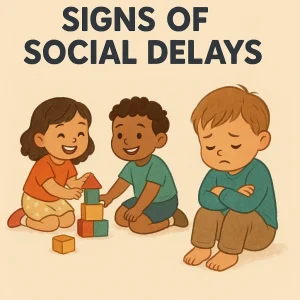Managing Screen Time: Parental Tips for Preventing Virtual Autism
Last Updated: September 20, 2024
In today’s fast-paced digital world, technology has become a major part of our children’s everyday lives. From learning apps and video games to social media and entertainment, screens are everywhere. While technology can be a great tool for learning and fun, there’s a growing concern about its impact on young children’s development, particularly when it comes to something known as virtual autism.
Virtual autism refers to developmental delays in children, especially younger ones, caused by excessive screen time. It can affect a child’s ability to communicate, focus, and develop social skills. While screens can be educational, too much passive screen time can lead to problems such as delayed speech, poor eye contact, and difficulty in interacting with others.
What is Virtual Autism?
[youtube v=”TOoWqvX7T2A”]
Virtual autism is a term used to describe developmental delays in young children, primarily caused by excessive screen time. While autism itself is a neurodevelopmental disorder, virtual autism is more about how too much exposure to screens, especially during early developmental years, can lead to behaviors that mimic autism symptoms. It’s important to note that virtual autism is not the same as traditional autism, but the effects on a child’s social, emotional, and communication skills can be concerning.
Read More: Virtual Autism: Things that you need to know
Why Too Much Screen Time is Harmful
We all know screens are part of daily life, but when it comes to young children, too much screen time can cause more harm than good. Studies have shown that excessive screen time can negatively impact various aspects of a child’s development. From trouble focusing to delayed speech, the effects are real and can have long-term consequences if not managed properly.
Know more: Virtual Autism in Children: Real Concern or Screen Myth?
Negative effects of too much screen time include:
- Delayed Speech and Language Development: Children under the age of 5 are in a critical phase of learning to speak and understand language. When they spend more time watching screens than interacting with people, their language development can suffer. Instead of practicing real-world conversations, they’re passively absorbing information.
- Problems with Focus and Attention: When a child is constantly stimulated by fast-moving images on a screen, it can make it difficult for them to focus on slower, real-life activities like reading, playing, or even interacting with others. This can lead to attention problems in school and daily life.
- Emotional and Behavioral Issues: Children who spend too much time in front of a screen may exhibit increased irritability, mood swings, and have trouble managing their emotions. Studies suggest a link between excessive screen time and increased risks of anxiety, depression, and difficulty forming healthy relationships.
[youtube v=”Nute8gmwP4Q”]
Tips for Setting Healthy Screen Time Limits
Finding a balance between screen time and real-life activities is key to helping your child thrive in today’s digital world. Here are some practical tips to help you set healthy screen time limits for your kids, while still allowing them to enjoy the benefits of technology.
Tip 1: Set a Screen Time Schedule
One of the simplest ways to control screen time is by setting clear limits on how long your child can use devices each day. Establish a daily or weekly schedule that works for your family, ensuring that screen time doesn’t take up most of your child’s day.
Read More: Understanding Virtual Autism: Impact of Screen Time
For example, you can allow an hour or two of screen time during weekends, with reduced time during school days. This structure helps children understand when it’s time for screens and when it’s time for other activities, encouraging balance in their daily routines.
Tip 2: Encourage Other Activities
Screens can be entertaining, but they shouldn’t be the only source of fun. Encouraging other activities like outdoor play, reading, puzzles, or crafts is a great way to reduce screen time. Physical activities help children develop motor skills, while reading stimulates their imagination and improves their language abilities.
Introducing a variety of engaging non-screen activities will make it easier for your child to look beyond the screen for entertainment and learning. You can make a list of activities your child enjoys and suggest them as alternatives when they ask for screen time.
Tip 3: Be a Role Model
Children learn a lot by watching their parents. If they see you constantly using your phone or watching TV, they’re likely to mimic your behavior. Set an example by limiting your own screen time and engaging in other activities with your child, such as reading a book together or playing outside.
When you demonstrate healthy digital habits, it becomes easier for your child to understand why screen time limits are important. Plus, it can turn into a bonding opportunity for the entire family.
Tip 4: Create Screen-Free Zones
Designating certain areas of your home as “screen-free zones” can significantly reduce excessive screen time. For example, keeping screens out of bedrooms or away from the dinner table encourages family interaction and healthy routines. Screen-free mealtimes give everyone a chance to connect, and screen-free bedrooms promote better sleep and relaxation.
Also read: Effective Therapies for Virtual Autism: What Really Works?
Screen Time Recommendations by Age
When it comes to screen time, different age groups have different needs. Setting screen time limits according to your child’s age is a great way to ensure healthy development while still allowing them to enjoy the benefits of technology. Let’s break it down by age group.
Toddlers (Under 2 Years Old)
For children under two, it’s recommended to have little to no screen time. The World Health Organization (WHO) and the American Academy of Pediatrics suggest avoiding screen time altogether at this age, except for video chatting with family members. This is because toddlers need face-to-face interactions and playtime to develop essential social, cognitive, and motor skills.
Why it matters:
Too much screen time at this age can interfere with your child’s ability to develop language and emotional connections. Babies and toddlers learn best from direct interactions with caregivers, not passive watching.
Preschoolers (Ages 2-5)
For children aged 2 to 5, the recommendation is to limit screen time to no more than one hour per day. This screen time should be high-quality and educational, like learning apps or interactive games that involve parent participation. Avoid passive viewing for long periods, such as watching cartoons or videos.
Why it matters:
During these years, children are learning how to speak, interact, and play. Too much screen time can delay speech development and reduce their ability to focus on real-life tasks, which could mimic early signs of virtual autism.
School-Aged Children (Ages 6-12)
For children between the ages of 6 and 12, experts recommend keeping screen time to 1-2 hours per day for non-school-related activities. It’s important to monitor the content they consume and encourage a balance between screens and physical or creative activities like playing outside, reading, or engaging in hobbies.
Why it matters:
At this age, children are developing critical thinking and problem-solving skills. Excessive screen time, especially with entertainment-based media, can negatively impact their attention span and social skills. This is also when children are most at risk for developing virtual autism symptoms due to a lack of real-world interaction.
Teenagers (Ages 13-18)
Teens often spend more time using screens for schoolwork, social media, and entertainment. For this age group, screen time should be limited to no more than 2-3 hours per day outside of schoolwork. Encourage breaks, outdoor activities, and face-to-face interactions to maintain a healthy balance.
Why it matters:
While teenagers are more independent, they still need guidance when it comes to balancing screen time. Too much screen use can impact their sleep, social interactions, and mental health. Setting boundaries helps prevent issues such as anxiety, depression, and, in some cases, screen addiction.
The Importance of Interactive Screen Time
Not all screen time is created equal. While passive watching, like scrolling through social media or watching cartoons, can be harmful if overdone, interactive screen time offers more meaningful experiences that can actually benefit your child’s development. Interactive screen time includes activities like playing educational games, engaging in virtual puzzles, or using apps that promote problem-solving skills. These types of activities encourage active participation and learning, rather than simply consuming content.
Why is interactive screen time better?
Interactive screen time stimulates cognitive thinking and keeps children engaged in activities that challenge them to think, learn, and solve problems. Educational apps and games help kids develop important skills like memory, attention, and language development, which are critical during their early years. When children engage with interactive content, they are more likely to retain information and build skills that can be used in real-world situations.
By contrast, passive screen time, like watching videos or television, often leads to overstimulation without much engagement. This type of screen time doesn’t require children to think or interact, and it can contribute to problems like poor focus or delayed speech.
Tip for parents: Get involved!
One of the best ways to make the most out of screen time is to join your child in learning or playing on the screen. Co-viewing or co-playing not only strengthens the bond between you and your child but also allows you to guide them through the educational process. For example, you can help your child understand the lessons from a game, ask them questions, and encourage them to think critically about what they’re learning. This active participation can turn screen time into a productive and interactive experience.
By being present and involved, you can also monitor the quality of the content your child is engaging with, ensuring it aligns with your family’s values and educational goals. Whether it’s exploring learning apps together or playing an interactive game, sharing these screen experiences can make them more meaningful and help mitigate the potential negative effects of screen time.
Screen Time Management Tips
| Tip | Why It’s Important |
|---|---|
| Set a Screen Time Schedule | Helps build a routine that balances screen time with other important activities like play, homework, and family time. It creates structure and limits overuse of technology. |
| Encourage Other Activities | Reduces reliance on screens by promoting physical activity, creativity, and real-world social interactions. Helps children develop a wider range of skills and interests. |
| Be a Role Model | Children imitate their parents’ habits. By demonstrating healthy screen habits, like limiting your own screen use, you show them the importance of balance. |
| Use Parental Control Tools | These tools provide an easy way to monitor and limit screen time without constant supervision, ensuring that children stick to the agreed-upon rules for digital use. |
| Create Screen-Free Zones | Designating certain areas, like the dinner table or bedrooms, as screen-free promotes face-to-face interaction and better focus, while also improving sleep and relaxation. |
Also read: Symptoms of Virtual Autism in The Digital Age
How to Spot Signs of Virtual Autism
As screen time continues to grow in children’s daily routines, it’s crucial to watch for any signs of virtual autism. Virtual autism occurs when a child’s developmental progress is hindered by excessive exposure to screens, leading to behaviors similar to those found in children diagnosed with traditional autism. Fortunately, these signs can often be reversed or improved by reducing screen time and increasing real-world interactions.
Here are some common signs of virtual autism to watch for:
- Less Talking or Delayed Speech: If your child is speaking less than other kids their age or struggling to form sentences, it may be a sign that they are spending too much time with screens instead of engaging in real-life conversations.
- Poor Eye Contact: One of the early signs of virtual autism is a noticeable lack of eye contact. If your child avoids looking at you or others during conversations or while playing, it could be due to excessive screen exposure.
- Avoiding Social Situations: A child who prefers to stay glued to screens rather than interacting with family, friends, or other children might be experiencing the effects of virtual autism. Look for signs that your child is less interested in playing with others or engaging in group activities.
- Repetitive Behaviors: Children who are overly focused on watching the same video or playing the same game repeatedly may show signs of limited engagement in diverse, stimulating activities. This kind of behavior can reduce their willingness to explore new things.
- Difficulty Focusing or Paying Attention: If your child seems easily distracted or has a hard time focusing on activities that don’t involve screens, this could be a sign of overstimulation from fast-paced digital content.
Conclusion
Managing your child’s screen time is essential for their healthy growth. Setting clear boundaries can help prevent the effects of virtual autism and ensure your child gets the right balance of technology and real-world experiences. Screens can be a helpful tool, but it’s important to also make time for activities like outdoor play, family interactions, and creative learning. By following simple steps, like having a screen time schedule and encouraging other activities, you can make sure your child benefits from technology without overdoing it.
Remember, you have the power to shape how your child uses screens. Reducing screen time and focusing on real-life interactions will support their social and emotional development. At Wellness Hub, we’re here to help you with tips and resources to navigate parenting in the digital age. By finding the right balance, you can help your child grow in a healthy, well-rounded way.
Frequently Asked Questions:
1. What is virtual autism?
Virtual autism refers to developmental delays in children caused by excessive screen time. It can lead to symptoms similar to traditional autism, such as delayed speech, poor eye contact, and trouble interacting socially. Reducing screen time and increasing real-world activities can often help reverse these effects.
2. How does too much screen time affect my child’s development?
Excessive screen time can negatively impact your child’s focus, attention, language development, and social skills. Children who spend too much time on screens may experience speech delays, reduced emotional connection, and difficulty in forming healthy relationships with others.
3. How much screen time is appropriate for my child?
For toddlers under 2 years old, it’s best to avoid screen time altogether, except for video chatting. Preschoolers (2-5 years) should have no more than 1 hour of screen time per day. For school-aged children and teens, limit screen time to 1-2 hours per day outside of school-related activities.
4. What are some signs that my child might be experiencing virtual autism?
Signs of virtual autism can include less talking, poor eye contact, avoiding social situations, repetitive behaviors, and trouble focusing. If you notice these signs, try reducing screen time and increasing interactive, real-world activities. If the signs persist, consider speaking with a professional.
5. What is interactive screen time and why is it important?
Interactive screen time involves activities where children engage and participate, like educational games or problem-solving apps. It’s much more beneficial than passive screen time, like watching videos, because it promotes active learning and development of critical thinking skills.
6. How can I set healthy screen time limits for my child?
You can set healthy screen time limits by creating a daily or weekly screen time schedule, encouraging activities like outdoor play and reading, being a role model with your own screen habits, using parental control apps, and designating screen-free zones in your home.
7. Can virtual autism be reversed?
In many cases, reducing screen time and increasing real-world interactions can help reverse the effects of virtual autism. Early intervention is key, so if you notice signs like delayed speech or poor social skills, try adjusting your child’s screen habits.
8. When should I talk to a professional about my child’s screen time?
If you notice persistent signs like delayed speech, poor eye contact, or avoiding social interactions even after reducing screen time, it may be time to consult a pediatrician or child development specialist for further evaluation and support.
9. How can I balance screen time and real-life activities?
To balance screen time, set clear boundaries on how much time your child can spend on screens, encourage them to engage in other activities like outdoor play or reading, and actively participate in screen time with them through co-viewing or co-playing.
10. How can Wellness Hub help with managing my child’s screen time?
At Wellness hub, we provide resources and expert advice to help parents navigate challenges like managing screen time and supporting their child’s development. Our tools and services can guide you in setting healthy boundaries and preventing the risks of virtual autism.
About the Author:
Anuradha Karanam
Speech-language pathologist (7+ years of experience)
Anuradha Karanam is a skilled speech-language pathologist with over 6 years of experience. Fluent in Tamil, Telugu, Hindi, and English, she specializes in parent counseling, speech sound disorders, fluency assessment, and speech-language evaluations. Anuradha excels at working with children with developmental disorders, offering creative and effective therapy programs. Currently, at Wellness Hub, she holds a BASLP degree and is registered with the RCI (CRR No A85500). Her patience, ambition, and dedication make her a trusted expert in her field.
Book your Free Consultation Today
Parent/Caregiver Info:
Client’s Details:
* Error Message









